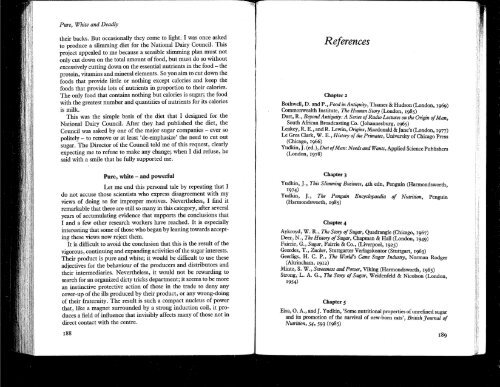John_Yudkin_-_Pure_White_and_Deadly_revised_1986_OCR
John_Yudkin_-_Pure_White_and_Deadly_revised_1986_OCR
John_Yudkin_-_Pure_White_and_Deadly_revised_1986_OCR
Create successful ePaper yourself
Turn your PDF publications into a flip-book with our unique Google optimized e-Paper software.
<strong>Pure</strong>, <strong>White</strong> <strong>and</strong> <strong>Deadly</strong><br />
their backs. But occasionally they come to light. I was once asked<br />
to produce a slimming diet for the National Dairy Council. This<br />
project appealed to me because a sensible slimming plan must not<br />
only cut down on the total amount of food, but must do so without<br />
excessively cutting down on the essential nutrients in the food - the<br />
protein, vitamins <strong>and</strong> mineral elements. So you aim to cut down the<br />
foods that provide little or nothing except calories <strong>and</strong> keep the<br />
foods that provide lots of nutrients in proportion to their calories.<br />
The only food that contains nothing but calories is sugar; the food<br />
with the greatest number <strong>and</strong> quantities of nutrients for its calories<br />
is milk.<br />
This was the simple basis of the diet that I designed for the<br />
National Dairy Council. Mter they had published the diet, the<br />
Council was asked by one of the major sugar companies - ever so<br />
politely - to remove or at least 'de-emphasize' the need to cut out<br />
sugar. The Director of the Council told me of this request, clearly<br />
expecting me to refuse to make any change; when I did refuse, he<br />
said with a smile that he fully supported me.<br />
<strong>Pure</strong>, white - <strong>and</strong> powerful<br />
Let me end this personal tale by repeating that I<br />
do not accuse those scientists who express disagreement with my<br />
views of doing so for improper motives. Nevertheless, I find it<br />
remarkable that there are still so many in this category, after several<br />
years of accumulating evidence that supports the conclusions that<br />
I <strong>and</strong> a few other research workers have reached. It is especially<br />
interesting that some of those who began by leaning towards accepting<br />
these views now reject them.<br />
It is difficult to avoid the conclusion that this is the result of the<br />
vigorous, continuing <strong>and</strong> exp<strong>and</strong>ing activities of the sugar interests.<br />
Their product is pure <strong>and</strong> white; it would be difficult to use these<br />
adjectives for the behaviour of the producers <strong>and</strong> distributors <strong>and</strong><br />
their intermediaries. Nevertheless, it would not be rewarding to<br />
search for an organized dirty tricks department; it seems to be more .<br />
an instinctive protective action of those in the trade to deny any<br />
cover-up of the ills produced by their product, or any wrong-doing<br />
of their fraternity. The result is such a compact nucleus of power<br />
that, like a magnet surrounded by a strong induction coil, it produces<br />
a field of influence that invisibly affects many of those not in<br />
direct contact with the centre.<br />
188<br />
References<br />
Chapter 2<br />
Bothwell, D. <strong>and</strong> P., Food in Antiqui~, Thames & Hudson (London 1969)<br />
Commonwealth Institute, The Human Story (London, 1985) ,<br />
Dart, R., BeyondAntiqui~: A Series 0/ Radio Lectures on the Origin 0/ Man<br />
South Mrican Broadcasting Co. (Johannesburg, 1965) ,<br />
Leakey, R. E., <strong>and</strong> R. Le~in, Origins, Macdonald & Jane's (London, 1977)<br />
Le Gros Clark, W. E., HIStory o/the Primates, University of Chicago Press<br />
(Chicago, 1966)<br />
<strong>Yudkin</strong>, J. (ed.),Dieto/Man: Needs <strong>and</strong> Wants, Applied Science Publishers<br />
(London, 1978)<br />
Chapter 3<br />
<strong>Yudkin</strong>, J., This Slimming Business, 4th edn, Penguin (Harmondsworth<br />
~~ ,<br />
<strong>Yudkin</strong>, J., The Penguin Encyclopaedia of Nutrition, Penguin<br />
(Harmondsworth, 1985)<br />
Chapter 4<br />
Aykroyd, W. R., The Story 0/ Sugar, Quadrangle (Chicago 1967)<br />
Dc:er! N., The History of. Sugar, Chapman & Hall (London: 1949)<br />
Farrne, G., Sugar, Fairne & Co., (Liverpool, 1925)<br />
Geer~es, T., Zucker, Stuttgarter Verlagskontor (Stuttgart, 1963)<br />
Geerligs, H. C. P., The World's Cane Sugar Industry Norman Rodger<br />
(Altrincham, 1912) ,<br />
Mintz, S. W., Sweetness <strong>and</strong> Power, Viking (Harmondsworth, 1985)<br />
Strong, L. A. G., The Story o/Sugar, Weidenfeld & Nicolson (London<br />
1954) ,<br />
Chapter 5<br />
Eisa, 0: A., <strong>and</strong> J: <strong>Yudkin</strong>, 'Som~ nutritional properties of unrefined sugar<br />
<strong>and</strong>~t~ promonon of the SurvIVal of new-born rats', British Journal of<br />
Nutntzon, 54, 593 (1985)



